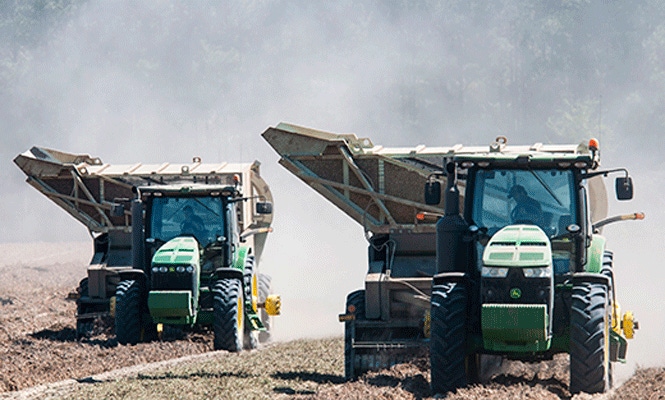March 2, 2016

Things have changed a lot in 150 years since the Davis family started farming in Jackson County, Florida. Instead of walking behind mule-pulled plows, they ride in air conditioned, self-driving, GPS-guided 295-horsepower tractors.
Sonny Davis, the eldest of five brothers, is a little leery of the new technology. “If you are 40 years old or older, you don’t need to get in there,” he said. But then the first tractor he remembers as a small boy was an 8n Ford tractor, a lot like a riding lawn mower.
Every fall Sonny and his brothers Michael, Keith, Roger and Randy, along with their sons, meet at the barn where the grandfather’s house stood in the 1800s. Even though the brothers manage independent operations, when it is time to plant and harvest they work together. All live a few miles from each other and grow cotton, peanuts, corn, soy beans and timber and raise cattle on more than 7,500 acres. By working together, young and old, the Davis family can share the equipment and technologies to practice precision agriculture.
It was the sons and nephews who pushed the family to adapt. “They love the tech. I just want my phone to work,” Sonny said. When his nephew got a text from the tractor’s computer system notifying him of a locked clutch, instead of adjusting it with a wrench, he hooked his computer up to the tractor and repaired it in 30 minutes.
The Davises customize how they cultivate each acre using Global Positioning System (GPS) technology to plant and harvest, and grid soil sampling to map and analyze their fields to precisely apply fertilizer and pesticides. “In a sampling of a 25-acre field, only two acres needed lime treatment, saving better than 20 percent on the cost for fertilizer,” Sonny said. The satellite guidance systems automatically shut off seed-planting and chemical spraying functions on their tractors when passing over areas that have already been covered. In their world full of small fields, around 30 acres, Sonny said the technology really makes a difference.
Software saves the coordinates where they plant crops that are used later to harvest. This is especially helpful when the Davises dig peanuts; a feat usually performed more by artful guess than science. Precision agriculture cuts production costs and saves energy, improves crop yields, reduces pollution, improves water quality, saves labor and contributes to more accurate farming records.
But tech tools are expensive. Today a GPS-ready John Deere 8285 costs around $205,000, while the GPS equipment and the subscription are an additional $22,000. Compare that to the multiuse John Deere 4850 tractor Sonny paid about $45,000 for in the late 80s. The family jointly owns at least 20 tractors, six peanut harvesters and five cotton pickers.
USDA’s Natural Resources Conservation Service technical and financial assistance helped the Davises to adopt soil mapping through the Environmental Quality Incentives Program (EQIP). “I have worked with NRCS as long as I can remember. It would have been hard, or impossible to adopt these practices without their assistance,” Sonny said.
He remembers NRCS staff encouraging him to adopt no-till in the 70s and now he plants cover crops to control erosion. “We have more heavy rains in a short length of time. Cover crops slow the runoff and prevent washouts,” he said. The practice also increases the soil’s ability to maintain moisture, so they only irrigate 20 percent of their land. “We care about the environment. I don’t like to see erosion,” Sonny said.
Sonny has been on the Jackson County Soil and Water Conservation District board for more than 20 years and serves on the Cloverleaf Gin and the National Peanut board. Last November Jackson County recognized Davis Farms as the 2015 Conservationist of the Year for practices that have improved soil and water quality in the watershed.
“We have evolved to use these techniques, the entire family is doing it and sharing the expense of the equipment. You put that together and we are sharing savings,” Sonny said.
For more information, visit your local NRCS field office. To learn about technical and financial assistance available from NRCS, go to Getting Started with NRCS.
You May Also Like




